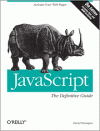JavaScript and XML : Page 4 | JavaScript: The Definitive Guide, Fifth Edition
[previous] [next]
JavaScript and XML
21.2 Manipulating XML with the DOM API
The previous section showed a number of ways to obtain parsed XML data in the form of a Document object. The Document object is defined by the W3C DOM API and is much like the HTMLDocument object that is referred to by the document property of the web browser.
The following subsections explain some important differences between the HTML DOM and the XML DOM and then demonstrate how you can use the DOM API to extract data from an XML document and display that data to a user by dynamically creating nodes in the browser's HTML document.
21.2.1 XML Versus HTML DOM
Chapter 15 explained the W3C DOM but focused on its application in client-side JavaScript to HTML documents. In fact, the W3C designed the DOM API to be language-neutral and focused primarily on XML documents; its use with HTML documents is through an optional extension module. In Part IV, notice that there are separate entries for Document and HTMLDocument, and for Element and HTMLElement. HTMLDocument and HTMLElement are extensions of the core XML Document and Element objects. If you are used to manipulating HTML documents with the DOM, you must be careful not to use HTML-specific API features when working with XML documents.
Probably the most important difference between the HTML and XML DOMs is that the getElementById() method is not typically useful with XML documents. In DOM Level 1, the method is actually HTML-specific, defined only by the HTML Document interface. In DOM Level 2, the method is moved up a level to the Document interface, but there is a catch. In XML documents, getElementById() searches for elements with the specified value of an attribute whose type is "id". It is not sufficient to define an attribute named "id" on an element: the name of the attribute does not matterÂonly the type of the attribute. Attribute types are declared in the DTD of a document, and a document's DTD is specified in the DOCTYPE declaration. XML documents used by web applications often have no DOCTYPE declaration specifying a DTD, and a call to getElementById() on such a document always returns null. Note that the getElementsByTagName() method of the Document and Element interfaces works fine for XML documents. (Later in the chapter, I'll show you how to query an XML document using powerful XPath expressions; XPath can be used to retrieve elements based on the value of any attribute.)
Another difference between HTML and XML Document objects is that HTML documents have a body property that refers to the <body> tag within the document. For XML documents, only the documentElement property refers to the top-level element of the document. Note that this top-level element is also available through the childNodes[] property of the document, but it may not be the first or only element of that array because an XML document may also contain a DOCTYPE declaration, comments, and processing instructions at the top level.
There is also an important difference between the XML Element interface and the HTMLElement interface that extends it. In the HTML DOM, standard HTML attributes of an element are made available as properties of the HTMLElement interface. The src attribute of an <img> tag, for example, is available through thesrc property of the HTMLImageElement object that represents the <img> tag. This is not the case in the XML DOM: the Element interface has only a singletagName property. The attributes of an XML element must be explicitly queried and set withgetAttribute(), setAttribute(), and related methods.
As a corollary, note that special attributes that are meaningful on any HTML element are meaningless on all XML elements. Recall that setting an attribute named "id" on an XML element does not mean that that element can be found with getElementById(). Similarly, you cannot style an XML element by setting its style attribute. Nor can you associate a CSS class with an XML element by setting its class attribute. All these attributes are HTML-specific.
21.2.2 Example: Creating an HTML Table from XML Data
Example 21-7 defines a function named makeTable() that uses both the XML and HTML DOMs to extract data from an XML document and insert that data into an HTML document in the form of a table. The function expects a JavaScript object literal argument that specifies which elements of the XML document contain table data and how that data should be arranged in the table.
Before looking at the code for makeTable(), let's first consider a usage example. Example 21-6 shows a sample XML document that's used here (and elsewhere throughout this chapter).
Example 21-6. An XML datafile
The following HTML fragment shows how the makeTable() function might be used with that XML data. Note that the schema object refers to tag and attribute names from this sample datafile:
The implementation of makeTable() is shown in Example 21-7.
Example 21-7. Building an HTML table from XML data

This excerpt is taken from Chapter 21 of JavaScript: The Definitive Guide, Fifth Edition, published by O'Reilly Media, Inc., Copyright © 2006, 2002, 1998, 1997, 1996 O'Reilly Media, Inc. All rights reserved.
[previous] [next]
URL:


 Find a programming school near you
Find a programming school near you